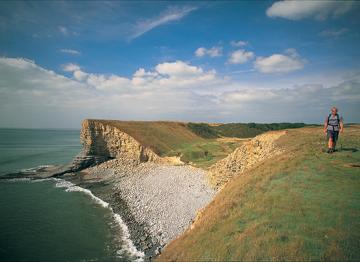Glamorgan Heritage Coast
Land of shipwrecks, pirates, horse riding, some of the largest sand dunes in Europe, thatched cottages and imposing ruins. This is the Glamorgan heritage coast which boasts beautiful sandy beaches, rugged cliffs and famous caves. Beautiful landscapes invite you to explore them and discover the history that created them.
 The South East Coastline offers some great beaches in the different counties of Glamorganshire. These range from the popular waves at Rest Bay, the sheltered protection of Coney Beach and the excellent quality of Llantwit Major. There are also fantastic beaches around Macross and Monknash. The villages of Monknash and Marcross lie close to the heritage coast. In the 12th century Monknash was an annex of Neath Abbey, helping to keep the monks supplied with grain and produce. Nearby are the imposing cliffs of Marcross. A lighthouse stands on the headland at Nash Point. The Plough and Harrow country pub in Monknash and The Horseshoe Inn in Macross are definitely worth a visit and both serve excellent food.
The South East Coastline offers some great beaches in the different counties of Glamorganshire. These range from the popular waves at Rest Bay, the sheltered protection of Coney Beach and the excellent quality of Llantwit Major. There are also fantastic beaches around Macross and Monknash. The villages of Monknash and Marcross lie close to the heritage coast. In the 12th century Monknash was an annex of Neath Abbey, helping to keep the monks supplied with grain and produce. Nearby are the imposing cliffs of Marcross. A lighthouse stands on the headland at Nash Point. The Plough and Harrow country pub in Monknash and The Horseshoe Inn in Macross are definitely worth a visit and both serve excellent food.
Llancarfan - One of the smallest villages in the Vale of Glamorgan, Llancarfan is mostly unspoiled and witnessed the founding of a Celtic monastery in the 6th century by St Cattwg. The present 13th century church was built on the site and has many historic features, including an embattled tower. A hill fort known as Castle Ditches lies close to the village. The area has numerous legends associated with nearby caves and forests. Llancarfan is also famous for its Village ford, and the delightful country pub the Fox and Hounds.
Llantwit Major population is approx 14,000. The areas close proximity to Cardiff the capital city of Wales makes access to the vale easy , with regular bus and train services to the principle towns and rural areas. In a recent survey, Llantwit Major was nominated as one of the best places in the UK to live.
Secluded Cowbridge is often described as the capital of the Vale of Glamorgan, an elegant market town with a wealth of historic buildings. It dates back to Romans times and boasts the remains of a 14th century castle and a museum contained within a cell block at the town hall. The 12th century Church of the Holy Cross has an embattled tower. Nearby is the site of a famous victory by Owain Glyndwr while Llanerch Vineyard at Hensol is the largest vineyard in Wales. At Llanblethian is the restored gatehouse of medieval St Quentin’s Castle while on a hill are the remains of an Iron Age fort. Beaupre Castle is a manor house dating to the 14th century. Dyffryn Gardens lie on the edge of Cowbridge and contain the Edwardian Dyffryn House.
Merthyr Mawr is an idyllic little settlement, as picturesque as they come, with an outstanding collection of Thatched Dwellings straight from the pages of a Thomas Hardy novel, beautifully positioned around an old Village Green. Surrounded by meadows and woodlands, the Ancient Church, which dates back to the middle of the 19th century, was built on an ancient site that still stands guard over the residents. If you are a fan of obscure, long-lost historic sites, then search out Candleston Castle, once a 15th century fortified mansion house on the edge of the Sahara-like dunes of Merthyr Mawr Warren. It is now an ivy covered ruin that was the centre point of the village of Treganlaw, buried beneath the ever shifting sands of Merthyr Mawr Warren. The present warren is all that is left of what was once the Largest Sand Dune Complex In Britain, stretching along the coast to Mumbles. The warren is an important wildlife habitat and site of scientific interest, which shelters a rich variety of plants. Parts of the Hollywood blockbuster ‘Lawrence of Arabia’ were filmed here.
